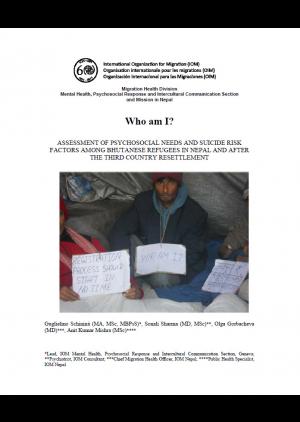Description
In 2010 an alleged disproportionately high number of suicides among Bhutanese refugees resettled in the US, and an equally alleged disproportionately high number of succeeded and attempted suicides among Bhutanese refugees in the camps in Nepal came to the attention of humanitarian and governmental agencies. The anecdotal nature of the reports, based mainly on media accounts, and the superficial nature of the proposed explanations to the phenomenon highlighted the need for an investigation into the issue and for the development, in case data were confirmed, of a series of recommendations to prevent suicides. With these general aims, in January 2011, the International Organization for Migration, in coordination with UNHCR and PRM, conducted a three-week assessment on psychosocial well-being and suicide risk factors among Bhutanese refugees in Nepal, and the ones resettled in the United States. The specific objectives of the rapid appraisal study were to:
- Confirm the magnitude of suicides among Bhutanese refugees in camps and upon resettlement, in absolute terms and in comparison with other populations, and analyze statistical correlations and chronological trends, in order to identify risk categories and factors.
- Investigate possible cultural explanatory systems for suicide, and if a specific “culture” of suicide existed in the camps.
- Investigate if general levels of distress in the camps could create an environment for suicide, possible causes of and responses to distress and possible co-existence of mental health problems in the ones, who attempted or committed suicide.
- Review overall psycho-social and mental health services provided to the refugee population in general and more specifically related to suicidal cases.
- Observe refugee resettlement processes in order to identify gaps and possible improvements which might prevent or mitigate mental uneasiness, including suicide.
Region/Country (by coverage)
Publisher
International Organization for Migration
